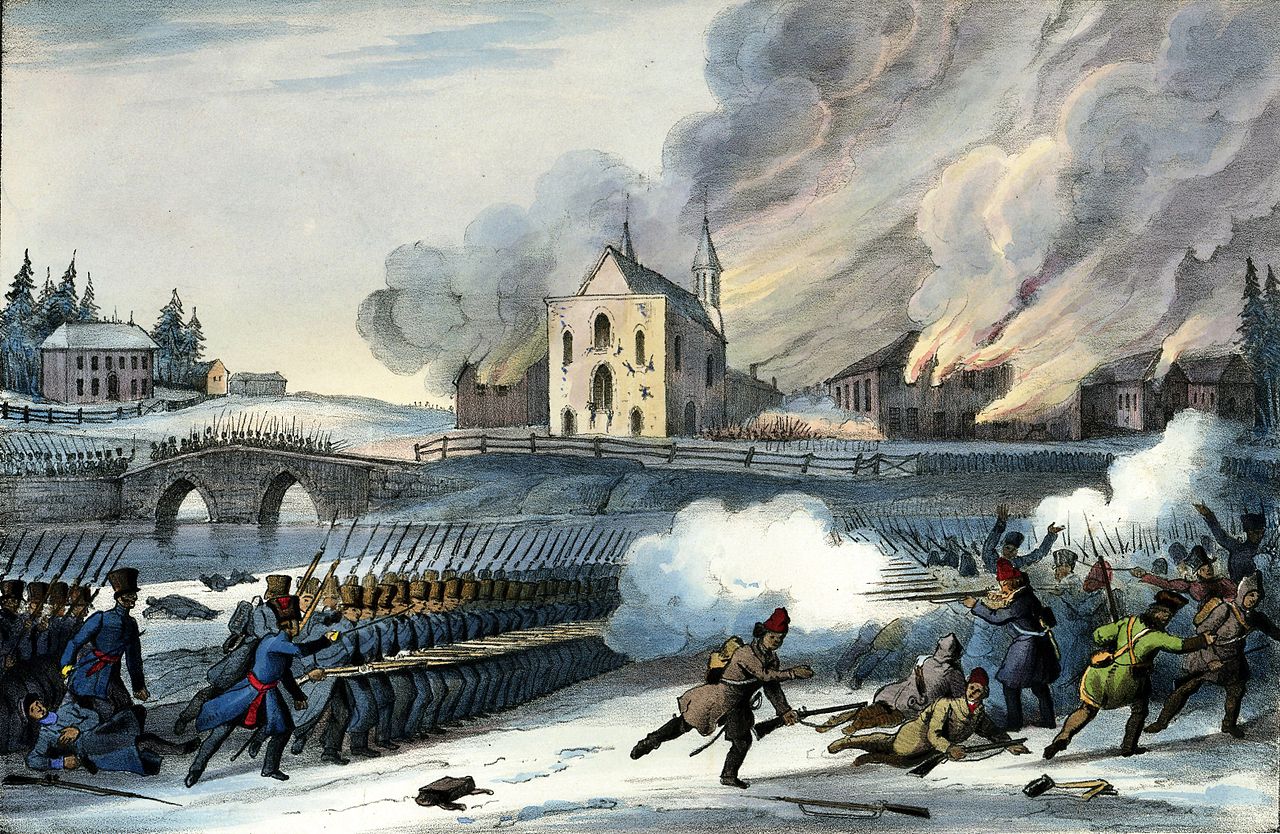One of the first rights campaigns in Canadian history was associated with securing democratic government. In the early nineteenth century, British colonial governors in Lower and Upper Canada jailed journalists and closed newspapers. Due process was ignored, and political and religious rights were limited. Political activists throughout the British colonies demanded that the Crown protect basic civil and political rights, and that it implement responsible government. At this time, rights were defined largely in terms of political freedoms, private property, religion, due process, and personal security.
In 1837, after years of brutal repression, Louis-Joseph Papineau, Robert Nelson, and others, called the Patriotes, rebelled against British power in Lower Canada. As the British emptied their garrisons to reinforce troops in Lower Canada, William Lyon Mackenzie attempted to exploit the opportunity with his own rebellion in Upper Canada. Mackenzie’s march on York (later called Toronto) failed miserably, and after several bloody battles around Montreal, the British crushed the French Canadian rebels. British autocracy had defeated representative democratic government.
The British responded to the 1837-38 uprisings by invoking emergency legislation. Martial law was declared in Upper and Lower Canada, which allowed the governor in Lower Canada to put aside elected legislators and judges who were sympathetic to his political opponents. In 1838, the British Parliament quickly replaced the Lower Canada legislature with the Special Council, which was appointed by the governor. In Upper Canada, the legislature suspended habeas corpus for people who were accused of treason or of possessing knowledge about treasonous activities. It passed the Lawless Aggression Act, which facilitated the confiscation of property as well as the prosecution of rebels by enabling juries to be selected outside the jurisdiction, putting individuals on trial in absentia, and allowing regular courts to hear felony cases. Normally, only those who owed allegiance to the Crown could be charged with high treason, but the legislation extended the definition of treason to include invaders from foreign countries that were at peace with Britain (rather than treating them as prisoners of war) and allowed them to be tried in military tribunals (without juries, which could not be trusted to convict). The legislature also passed a law empowering constables and justices of the peace to disperse any unlawful meeting or assembly and to arrest or detain the participants. Inversely, those who engaged in illegal acts to protect the Crown were given special immunities from prosecution. In Lower Canada, the Special Council passed thirty ordinances to deal with the security threat; among other things, they granted the governor special powers to search private dwellings, declared that secret societies were illegal, and categorized participation in such societies as treason. The council implemented the highly unorthodox practice of putting civilians on trial in courts martial during peacetime. Imposing the unusual provision of retroactive guilt, the Court Martial Ordinance restricted access to defence counsel and made guilt punishable by death. All told, the trials that followed the rebellions resulted in the execution of 32 men, the exile of 144, and 248 convictions for a host of crimes. The newspapers La Minerve, Vindicator, and the Constitution were all shut down.
In part, the rebellions were a response to the brutal practices of British governors and their attempts to suppress the French minority. As historian Michel Ducharme explains in Le concept de liberté, his seminal work on the concept of liberty during the rebellions, liberty was the rallying cry of colonial reformers during the nineteenth century. In an era that espoused a hereditary monarchy, rights of conquest, aristocratic privilege, and monarchical government, there was nothing more revolutionary than principles that challenged the legitimacy of the state and the social order. William Lyon Mackenzie, the leader of Upper Canada’s abortive insurrection, drafted a constitution in 1837 that recognized “civil and religious liberty,” and provided guarantees against excessive bail costs and cruel and unusual punishments. The republicans who drafted Lower Canada’s “Ninety-Two Resolutions,” which became a manifesto for the Patriotes, demanded freedom of religion, physical security, and due process of law. Patriote leader Robert Nelson issued a declaration of independence in 1838 that explicitly referred to religious freedom, free speech, trial by jury, and the right to vote and speak in French or English in all public matters. The mandate of the Sons of Liberty, a secret militant association of French Canadians led by Louis-Joseph Papineau, was founded on the belief that “governments are instituted for the advantage of, and can justly exist only with the consent of those governed … A government by choice is no less an inherent right of the people.” The Sons of Liberty sought “strict equality before the law for all classes regardless of origin, language or religion.” [Journal d’un Fils de la libert] Those beliefs, and the British repression of French Canadians, made insurrection inevitable.
In his famous 1839 report to investigate the grievances that led to the rebellions, Lord Durham recommended the complete assimilation of the French population.
Further Reading
- Ducharme, Michel. Le concept de liberté au Canada à l’époque des révolutions atlantiques, 1776-1838. Montreal and Kingston: McGill-Queen’s University Press, 2010.
- Greenwood, F. Murray, and Barry Wright, eds. Canadian State Trials: Rebellion and Invasion in the Canadas, 1837-1839. Vol. 2. Toronto: University of Toronto Press, 2002.
- Louis-Joseph Papineau, Journal d’un Fils de la liberté, réfugié aux États-Unis, par suite de l’Insurrection canadienne, en 1837 (Montreal: Réédition-Québec, 1972).

